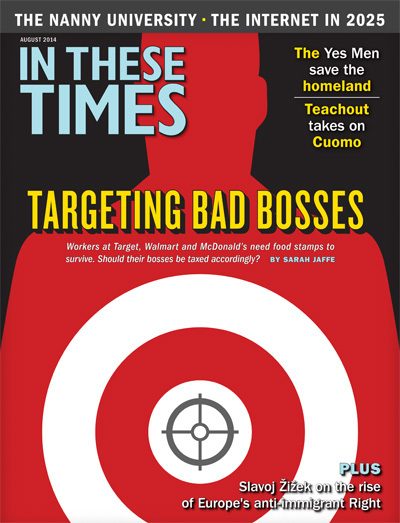
In the social-justice blogosphere, “trigger warnings” have long been standard etiquette for discussing violence or oppression. The warnings preface particularly graphic or disturbing content, cautioning readers with post-traumatic stress disorder that the linked or discussed material may cause flashbacks or other symptoms of trauma. However, in the past year, the trigger warning has leapt from the Internet to the academy. There’s been increasing pressure, particularly from students, for professors to use them in classrooms, flagging required course material that may be disturbing. Oberlin College’s Office of Equity Concerns, for example, suggested that Chinua Achebe’s Things Fall Apart receive a trigger warning for “racism, colonialism, religious persecution, violence, suicide and more.”
There has been substantial pushback from professors against mandatory trigger warnings. We invited a panel of educators to discuss their takes: Lynn Comella, a sexuality scholar and associate professor of women’s studies at University of Nevada, Las Vegas; Roxane Gay, author of An Untamed State and associate professor of English at Purdue; and Angus Johnston, who teaches history at Hostos Community College and runs the website StudentActivism.net.
Do you use trigger warnings in your classrooms?
Roxane: I don’t use trigger warnings in my classroom, and I never will.
Lynn: I don’t, and I have no plans to change that.
Angus: I just started using them. It’s a simple one-paragraph statement in my syllabus. All it says is, number one: Some of the material that we cover in class may be traumatic or troubling. I teach world history, so I teach a lot of very difficult material. Secondly, I welcome it if you want to talk about your personal responses to the material. If you need to step out of a class because the conversation has gotten overwhelming, there’s no penalty. The third thing is that, if students have particular triggers they’d like to let me know about, they can feel free to talk to me privately.
How do we define “difficult” material?
Angus: I think the stuff that is often most difficult in my classes pertains to the history of race: the history of slavery, the history of Jim Crow, specifically lynching and sexual exploitation in the context of racism.
Lynn: I’m a women’s studies professor, and so much of what we teach is considered “difficult” material. Even the history of feminism could be construed as difficult material for resistant, conservative men in the class. I think there are ways to engage with students around difficult material without conjuring up the language of trauma.
Roxane: I think that using trigger warnings in the classroom begins to suggest that as teachers, we become mental health professionals. I have my own PTSD; there’s no way in hell I can help someone else with theirs, other than to listen and point them to counseling services. My classroom is the kind of classroom where [students] know that if they need to step out, they need to step out. Also, I teach creative writing, so students write about trauma constantly. There’s just no way for me to be able to predict what a student’s going to write about and how other people are going to respond.
Trigger warnings are common practice in social justice writing and in Internet communities. Do their implications change when they’re placed in an academic context?
Roxane: Trigger warnings have some use in an Internet context where you are dealing with communities that have a very high rate of trauma, and you’re also having an interaction with the technology, in the sense that you can click a link and you may not know what you’re going to see. But I don’t think the explicit trigger warning really translates to an academic setting.
Lynn: My concern about trigger warnings is that they segregate and mark particular kinds of marginalized knowledge. In the context of teaching pornography, I don’t include any trigger warning because, right off the bat, that frames the topic in a very particular way. Not only does it frame the topic as something that could do you harm, it’s borrowing the rhetoric about harm and trauma that’s been advanced by anti-pornography advocates, including conservative politicians and anti-porn feminists.
Angus: I absolutely agree that trigger warnings should never be mandatory. My decision is informed by the nature of my student body. I’m teaching a lot of students who have limited academic backgrounds. And I think a lot of them have been socialized to act in a deferential way towards professors. I had a student just this spring who came to me after class and said that the discussion of slavery that we were having had been emotionally difficult, and that she had wanted to step out, but that she hadn’t known whether that would be inappropriate. I’m just giving them information that I want them all to have.
Roxane: Angus, does it make a difference to you whether the student’s problem is framed as a mental health issue, versus somebody’s personal sensibilities or moral revulsion or sense of personal oppression? I currently teach at a rural state university. A lot of first generation students. A lot of conservative students. If they had their way, we would never talk about abortion, or race, or gender. I believe that college is about making you uncomfortable. I’m not saying this to traumatize you. But we’re here to make people think and push them out of their comfort zone.
Angus: When I wrote about my use of trigger warnings, the critics of trigger warnings who read it said, “Well, you’re not giving these explicit over-the-top trigger warnings, so it’s not really a trigger warning at all,” whereas the folks who support trigger warnings were overwhelmingly supportive. I think there’s a risk, when somebody says we need to do something about this — particularly if it’s an activist undergraduate student — that we take their proposal as something that we have to just give a thumbs up or thumbs down to, rather than as an opportunity to start a dialogue.
Lynn: I’m thinking less about that activist student than I am about the extent to which conservative administrators and even conservative state legislators can pick up the rhetoric around trigger warnings and run with it. I’m thinking about the case at the University of South Carolina Upstate where the Center for Women’s and Gender Studies program was sanctioned for teaching programs that included LGBT texts. Last I heard their funding had been cut. My concern is whether trigger warnings can become entry points for conservative moral panic.
Angus: It’s important to note, though, that when we’re thinking about power within the university, there’s a fight for faculty autonomy and also for student power. I think faculty can and should do more to advocate for students.
Can those opposed to trigger warnings see situations where they might be more welcome?
Roxane: As I wrote in an essay on trigger warnings for The Rumpus, I absolutely see circumstances where trigger warnings are needed. I’m just loath to put them on my work because in some ways it feels like a form of censorship — like okay, I need to cordon off this difficult thing. And for people who’ve been silent, that’s a difficult thing to swallow. I should add, saying I don’t believe in trigger warnings doesn’t mean I don’t believe one can’t be triggered. I’ve been triggered; lots of things are triggering. I just don’t know if there’s a protection from that.
Lynn: I would say the same thing: I’ve made a choice not to include them on my syllabi in part because I feel it would be opening up a can of worms as someone who teaches gender and sexuality studies. But that does not negate the reality that there are topics that are triggering. It certainly hasn’t emerged as a topic of conversation in my classes. If it did, I’d have to perhaps revisit my stance.
Angus, I’d ask you the inverse question: Are there situations where you’d feel skeptical about trigger warnings?
Angus: Absolutely. In my writing I very rarely use trigger warnings. My sense is that, if material may be traumatic, I should set it up in the headline. I also worry about faculty who enjoy shocking their students; instead of taking the demand for trigger warnings as an opportunity to rethink their behavior, they might just slap boilerplate trigger warnings into the syllabus, and then say, anytime a student complains, “It’s in the syllabus, you should have expected it.” I think if trigger warnings are to be used, they should be one small piece of creating the classroom in which students are able to step out of their comfort zones.
Jude Ellison Sady Doyle is an In These Times contributing writer. They are the author of Trainwreck: The Women We Love to Hate, Mock, and Fear… and Why (Melville House, 2016) and was the founder of the blog Tiger Beatdown. You can follow them on Twitter at @sadydoyle.









